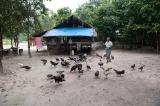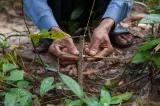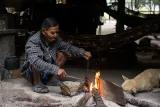
In 2018, journalist Matt Blomberg visited an indigenous Kuy community fighting against a seemingly unturnable tide of deforestation on Cambodia’s central plains. More than three years later, he returned with photographer Conor Wall to document a rare instance of indigenous people expanding their footprint in a world where ancient cultures are at threat of being washed away.

At the edge of a shallow lake in Cambodia’s central northern plains, three battered old men spend their days feeding chickens, weaving baskets, tending gardens, and wandering through the forest picking wild vegetables to cook in the evening, with little else to do before retiring each night.
The air is quiet and the pace of life is slow at this tiny settlement of huts built from luxury timber – like a retirement home for indigenous elders in the heart of the Beng Per Wildlife Sanctuary – but it hasn’t always been this way.
Around the fire at night, the trio relives battles with “outsiders and thieves,” ambushes, threats, and warning shots – many of them fired here, at a clearance in the forest that logging gangs for years used as a base until this unlikely posse of vigilantes chased them away, reclaiming pillaged timber for the beginnings of a new settlement that their children might one day live in.
“This is my final destination,” Nhean Vorng, 77, said one morning, sitting on a stump beside his greenhouse, where dozens of saplings wait to be transplanted in a forest stripped of its high-value hardwood.
“If the forest is to survive, the youth must take over our work,” said the former headman in Bongarn Pol, a nearby community of Kuy people that has for generations collected food, medicine, and building materials from a stretch of Beng Per that they call Chom Penh.
“But the youth have been misled by outsiders. I fear it’s already too late.”
Three years earlier, in mid-2018, Vorng packed two sets of clothes, a hammock, a spoon, and his tro – an ancient, two-stringed fiddle – into an old rice sack and walked out of Bongarn Pol for the last time with three lifelong friends, sensing a tipping point in the battle to save the woodlands where the spirits of their ancestors roam.
The four men – aged 67 to 79 – walked half a day to the southern edge of Chom Penh, a 3,422-hectare dot at the heart of Beng Per, a 242,500-hectare lowland forest, where they drove timber into the ground, strung up hammocks, and began to dig a well.
They named the place Boeng Chhouk – or lotus lake – erected a sign forbidding entry to “outsiders” and held a ceremony, confirming their presence to the spirits of the sky, land, and water, and requesting safe passage as full-time keepers of the forest.
For at least a decade, the ecosystems of Beng Per have been under siege, with more than a third of forest cover and almost all old-growth hardwood trees lost to pillagers and plantations, as a precious way of life for those who have mastered living from the landslips away.
But at the heart of the so-called sanctuary, this unlikely posse of jungle guardians has drawn a line in the forest floor. And Ruos Lim, a wily 67-year-old who can be off a moving tractor, up a tree and back with a baby-sized jackfruit in less than 20 seconds, is calling the shots.
“I know how to protect the forest. I know the law. I know the strategies,” Mr. Lim said one afternoon, rattling off full names, nationalities, and credentials of people he had met years earlier at a global meeting of indigenous leaders in the Philippines.
“I started learning about indigenous rights in 2014,” he said, with, as always, a dash of Hollywood. “Before that, you didn’t need to know.”
For Mr. Lim, the tiny settlement at the southern edge of Chom Penh - self-sufficient but for lighters and salt, and the factory-made cigarettes and cheap, potent energy drinks delivered by well-wishers at random - is a symbol of victory.
In 2020, his community of 200 families and two dirt roads at the northern end of Chom Penh had its claims to the forest extended all the way south to Boung Chhouk, almost doubling in size and, in theory, ending years of disputes over the rights and responsibilities of companies, community, and rangers.
“Outside that area, is not our concern,” he said, steely-eyed. “We have vowed to protect Chom Penh: no more, no less.”
Turning the tide
The least conspicuous encounter was the most ominous.
On the last leg of an intense four-day mission in 2018, patrollers sat in a roofless hut passing around a bottle of homemade rice wine and tearing shreds from a sun-dried fish to eat with handfuls of rice leftover from the morning cook up.
Without a word, Mr. Lim stood up and left.
About 40 meters away, he stopped on the middle of a dirt track snaking into the forest, jammed the sharp end of his machete into the ground, leaned on the handle, took some wild tobacco from his pocket, and began rolling it into a leaf from the kakhom tree, better known for its luxury wood.
A tractor rumbled into sight, heading toward the forest. Mr. Lim lit his cigarette and stood directly in its path, all 50kg of him, staring down the driver, who looked as strong and imposing as any farmer in outback Cambodia. A few meters short of Mr. Lim, the driver killed his engine and, clearly nervous, mumbled something about going to tend his crops.
Mr. Lim remained silent, slowly turning the cigarette between his lips as tension grew, glaring through wafts of smoke at the “intruder.” Without another word, the man churned his tractor back to life and reversed out of sight, back from where he had come.
Mr. Lim slung his scythe over his shoulder and let out a single round of his rusty old cackle, which wreaked of triumph, bravado, and, just maybe, a smidgen of relief. “If I see ten illegal loggers,” he told me later, “I catch 10 illegal loggers. This is a fact, and it is well known.”
Winding through sacred forest over the four days prior, Mr. Lim - a tracker and spy in the 1960s for the Khmer Rouge, when it was still a little-known jungle militia - pointed out mother trees scarred by chainsaws, piles of freshly cut timber and lonely stumps, the remnants of battles won and lost.
“This is the frontline,” he said near the site of his future settlement, a trace of menace in his eye. “If we find thieves here today, I’ll only be happy.”
Day and night, he took command in no less than a dozen clashes with loggers – some foiled while making their escape, some caught in the act, others sent back before the roar of their chainsaws could shake the air.
The elders chased down looters and forced them to cut stolen trees into useful pieces, then took them to build shelters at Boeng Chhouk. They lectured, intimidated, and took supplies from their targets – always younger, bigger, stronger, and often armed with sharp-edged farm tools and homemade guns.
“Do you think I’m scared of them,” Mr. Lim said when asked how he had managed to stay safe all these years, discharging a short burst of the rusty cackle, this time a scoff of indignation.
“I’ve been to war – bullets flying above, bombs exploding below. These guys would get one shot,” he said, imitating the use of homemade muskets that are common in rural Cambodia, “and then are just standing there helpless until they reload.”
On an afternoon scout of Chom Penh’s eastern perimeter, the comedian of the group took note of a butchered tree that had fallen from across the border.
“That’s our wood now,” said Proum Chum, a skilled weaver and trapper, emptying a satchel of instant coffee into his mouth, no need for water. “It’s nice. Maybe we should build a five-star resort.”
A dangerous game
Chum spent his youth in a traveling theatre group, where he mastered three characters: the shaman, the guru and the doofus, traces of which bubble forth on monotonous treks. But in Cambodia, working to defend nature is no joke.
Two of the most active environmental groups - Mother Nature and the Prey Lang Community Network – are outlawed by the government and their members often facing arrest and imprisonment in cases labeled bogus by observers and rights groups, as does Ouch Leng, a Goldman Prize winner known for daring expeditions into the heart of organized logging operations, which the government insists do not exist.
Indeed, the waters of right and wrong are perpetually muddied in Cambodia’s forests, where business interests – domestic and foreign – are often backed by authority, putting them at odds with local communities with genuine claims to long-held land.
Chut Wutty became Cambodia’s best-known environmental activist after leaving the military to campaign against its involvement in deforestation – and was shot dead by military police while escorting journalists into the southwestern Cardamom Mountains in 2012.
Six years later, three patrollers – a military police officer, a government ranger, and a staffer from a U.S. conservation group – were ambushed and murdered after confiscating chainsaws in the Keo Seima Wildlife Sanctuary in Cambodia’s far east. The killers were Cambodian soldiers, allegedly protecting a logging cartel from across the border in Vietnam.
In Beng Per, where most of the high-value trees have already been pillaged, organised logging is no longer a problem for Mr. Lim and his men. These days, most run-ins are with other indigenous folks whose own forests have been decimated or destroyed.
“It wasn’t so long ago that we lost our land,” said Hoklek Luon, a young indigenous community leader who studied law in Phnom Penh and often visits the Chom Penh elders. “Kuy people used to be the custodians of the land, left to manage it among themselves using traditional boundaries without much oversight. The forest gave us everything – we had no need to steal from each other.”
That began to change in 2012, he said, with the advent of “economic land concessions,” which saw more than half of Cambodia’s arable land carved up for plantations, much of it inside designated protected areas, where companies had the right to clear-cut forest and feed a thriving international market for precious wood.
The scheme has been plagued by scandal, with some concessions used to launder timber looted from surrounding forests, and others stripped of their riches then abandoned.
“One company has been here for ten years, talking about a rubber plantation,” Hoklek said one afternoon, as the patrol reached a place they call L4, where the forest gives way to vast, open fields. “Until now, they have not planted a single rubber tree.”
Hoklek is a treasure and a rarity among indigenous youth, said the elders, who saw communities begin to fray when a new road was built from an arterial highway through Beng Per in 2010, opening up a new world of influence and temptation.
“I noticed a difference in attitudes, personalities. It changed the identity of the community,” said Vorng, as gentle as a thousand grandfathers, explaining that young Kuy men could be swayed by beer, karaoke, and escorts to cut down their own forests. “The youth have lost touch with their culture,” he said.
Last year, Vorng’s best friend – one of the four pioneers of Boeng Chhouk – died after having a stroke while on patrol near L4, which is named for its coordinates on a map used by the elders to formalise their claims over Chom Penh.
“Everyone dies,” Vorng said of his mate, who was the older brother of Chum, the joker. “There is no greater honor than to live for some cause.”
While their tiny settlement marks a rare instance of indigenous people expanding their footprint in a world where ancient cultures seem under constant threat, there is also a sense of mourning among the elders – and a feeling that Boeng Chhouk is their escape from a village where they would watch their way of life slowly corroded by time.
Vorng and Chum appear content to see out their days here, tending chickens and flowers while playing sentry at the seemingly defunct entrance to Chom Penh.
But as they hunch together at night over a smartphone gifted by Hoklek, squinting as they watch old Khmer music videos, Mr Lim remains alert, sitting alone in his hammock, smoking bush cigarettes and staring off into the distance.
“The war here is won. This place is secure,” Mr Lim said of his mission to shore up the well-trodden path into Chom Penh. However, somewhat predictably, and with his trademark dash of Hollywood and cunning, he said it’d only be so long before he waded into a new battle. “The others can stay here if they want,” he said. “But soon I will move to L4 and start building a new camp there – even if I have to do it alone.”
Matt Blomberg is a multimedia journalist focused on environmental crimes, human trafficking and gender issues in Southeast Asia.
Photo gallery









